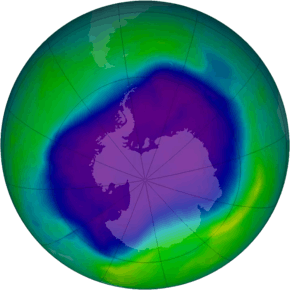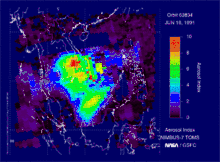Total Ozone Mapping Spectrometer
The Total Ozone Mapping Spectrometer (TOMS) is a NASA satellite instrument for measuring ozone values. Of the five TOMS instruments which were built, four entered successful orbit. Nimbus-7 and Meteor-3-5 provided global measurements of total column ozone on a daily basis and together provided a complete data set of daily ozone from November 1978 to December 1994. After an eighteen-month period when the program had no on-orbit capability, ADEOS I was launched on August 17, 1996, and provided data until the satellite which housed it lost power on June 29, 1997. TOMS-Earth Probe was launched on July 2, 1996, to provide supplemental measurements, and was later boosted to a higher orbit to replace the failed ADEOS I. The only total failure in the series was QuikTOMS, which was launched on September 21, 2001, but did not achieve orbit.[1] The transmitter for TOMS-Earth Probe failed on December 2, 2006.[2]
Since January 1, 2006, data from the Aura Ozone Monitoring Instrument (OMI) has replaced data from TOMS-Earth Probe.[3] The Ozone Mapping and Profiler Suite on Suomi NPP and NOAA-20 have further continued the data record.
Gallery
 Image of the largest Antarctic ozone hole recorded to date (September 2006).
Image of the largest Antarctic ozone hole recorded to date (September 2006). Mount Pinatubo 1991 ash and aerosol.
Mount Pinatubo 1991 ash and aerosol. Mount Pinatubo 1991 sulfur dioxide.
Mount Pinatubo 1991 sulfur dioxide. Sulfur dioxide emissions from volcanoes.
Sulfur dioxide emissions from volcanoes.
References
- ↑ "QuikTOMS Mission". NASA. July 10, 2001. Archived from the original on August 21, 2001.
- ↑ "News". Total Ozone Mapping Spectrometer. NASA. March 5, 2007. Archived from the original on August 29, 2012.
- ↑ "TOMS turns the mapping job over to OMI". Total Ozone Mapping Spectrometer. NASA. January 9, 2006. Archived from the original on January 27, 2006.
External links
| Wikimedia Commons has media related to Total Ozone Mapping Spectrometer. |